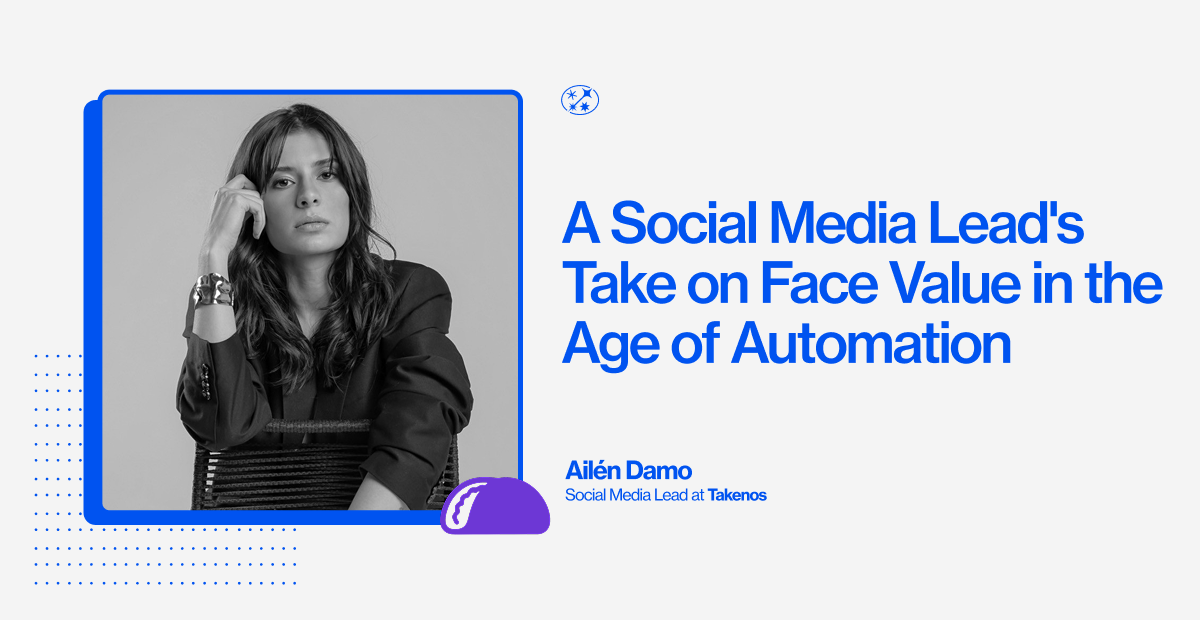
A Social Media Lead's take on Face Value in the Age of Automation
How can fintech brands stand out in the age of automation? Takenos’ Ailén Damo shares insights on trust, tone, and differentiation in the fintech industry.

Ailén Damo, Social Media Lead in Takenos
Fintech in LATAM has been booming for at least ten years. Its growth was natural due to the industry's opportunities in the region: messy economies with chronic inflation, political instability, and ever-changing financial and taxing regulations that make people uncertain about what to invest their money in.
However, with the fintech industry's growth came saturation and the need to stand out. As platforms race to optimize, automate, and scale, what makes a brand genuinely different? What builds long-term trust? And what happens when Gen Z starts calling your tone “cringe”?
We spoke with Ailén Damo, Social Media Lead at Takenos, to get a grounded take on brand building in the age of AI, why the best differentiators aren’t always visible from marketing, and why human attention—not just automation—might be fintech’s secret weapon.
Takenos is a LATAM-based fintech startup focused on simplifying how Latin Americans access and move their money across borders. In a region where financial friction is the norm, Takenos offers a streamlined alternative: transparent tools, intuitive interfaces, and real-time access to earnings, especially for cross-border workers and freelancers navigating multiple currencies and platforms.
At Takenos, Ailén leads the social media team with a sharp focus on scalable growth, influencer partnerships, and long-term brand positioning. Her goal? To turn Takenos into one of Latin America’s leading digital wallets. This is her take on the state of the industry:
Building Real Brand Differentiation in a Crowded Space
There’s been a fintech boom in LATAM in recent years. How do you approach building differentiation in such a competitive space?
I think the first step to building real differentiation in a saturated context is having an honest internal conversation. What are we actually good at? What need are we genuinely solving? It’s not enough to repeat your pitch; you have to get out there and take a good listen at your users.
In my role at Takenos, I work closely with other teams — product, ops, and CX — to identify those little blockers or friction points that might go unnoticed from a marketing perspective but are crucial for conversion and retention. That’s where the real differentiators show up.
Then comes the creative part. And that’s where curiosity and creativity become tools no one can copy. They help us anticipate what’s coming, take the pulse of the social mood in the country we’re operating in, and turn a technical solution into something people actually want to be a part of. I like to think a good strategy doesn’t just fix a funnel — it gets people to stop you on the street and say, “Hey, I use your app — love what you’re doing.” That human metric is key for me.
Trust in LATAM Is a Whole Different Game
A report from the Financial Technology Association shows that 85% of consumers and 90% of SMEs in the U.S. trust fintech platforms. Of course, we can’t extrapolate those numbers blindly — but do you see a similar level of trust in LATAM?
Yes, absolutely. But in LATAM, trust is built differently: through closeness, transparency, and (this is key) language.
There’s something really interesting happening with younger generations (even if I’m not Gen Z, I study them a lot): they’ve got a sharp radar for anything that feels fake. They value what’s real, what’s imperfect, what’s not trying to sell them something disguised as “value.” In that sense, brands that communicate from a more human place create real communities without fear of showing what they’re still building.
In a world where AI is solving processes at breakneck speed, I think the real differentiator is human attention, thoughtful responses, empathetic support, knowing when not to automate, and when it’s time to roll up your sleeves and get the whole team thinking about how to improve someone’s life and experience.
The Mistake? Talking Down—and Over—Your Users
What’s the most common communication mistake fintechs make?
Underestimating the user… and, at the same time, overestimating them. I know it sounds contradictory, but it’s not.
On one hand, there's this assumption that “if it’s in the app” or “if we sent an email,” we’re covered. But trust doesn’t come from an onboarding PDF no one will read: it’s built into every interaction, in how you answer a question or show up on social media. When brands focus too much on function, they often lose the human factor.
On the flip side, there’s the urge to be cool at all costs. Jumping on every trend, using slang that doesn’t feel authentic, and trying to “speak Gen Z” without actually understanding them. That shows too — and it often backfires.
The brands that build for the long haul are the ones that evolve without losing their voice. That understanding being relatable doesn’t mean forcing a tone, but having a clear, consistent identity over time.
Start Making People Feel Something: The definitive social media trend for the 2020’s
What emerging social media trend matters most for the fintech sector in 2025?
We’re in a fascinating moment. Tech has advanced so much that the edge no longer lies in who has the most tools, but in who has the best judgment using them. AI will keep growing, yes — but the key isn’t “what can a bot do to optimize our workflow?” It’s: how can we use it to amplify what makes our brand unique?
Some trends I find relevant:
- Curated AI-generated content: not generating for the sake of it, but using AI to scale ideas that already have soul — the ones born in brainstorms that ran way longer than planned.
- Emotional revivals: In Argentina, we’re seeing a lot of retro campaigns reimagined through a modern lens. It taps into a nostalgia that builds closeness and trust.
- Authenticity over polish: The era of perfectly aesthetic content is fading. What’s spontaneous, imperfect, and real is gaining value. We’re even seeing this in video: people engage way more with handheld, “badly edited” phone clips than with fully produced, motion-heavy reels.
- Influencers with substance: less aspirational lifestyle, more people teaching you something from honest experience. In fintech, creators who explain what no one else does are key brand ambassadors.
- Countercultural content: saying something different — even if it makes people uncomfortable — is starting to perform better than saying what’s “expected.”
At the end of the day, what works is what strikes a real chord in a world where we trust polished content less and growingly look for connection in things that make us feel part of something.
One prediction?
We’ll stop talking about users and go back to talking about people. Technical marketing had its moment, but human marketing is what sticks. Creativity is coming back to the decision-making table. The most important calls won’t be made exclusively by performance experts but by people who know how to read behaviors, connect emotionally, and pitch ideas with real impact.
Where to go next
- Ailen’s LinkedIn profile
- LATAM’s SEO Master on What Comes Next: Search Everywhere Optimization | Postdigitalist
- How we Relaunched a leading crypto company's newsletter & video series, with 124% ROI
- Book a workshop with us today.



